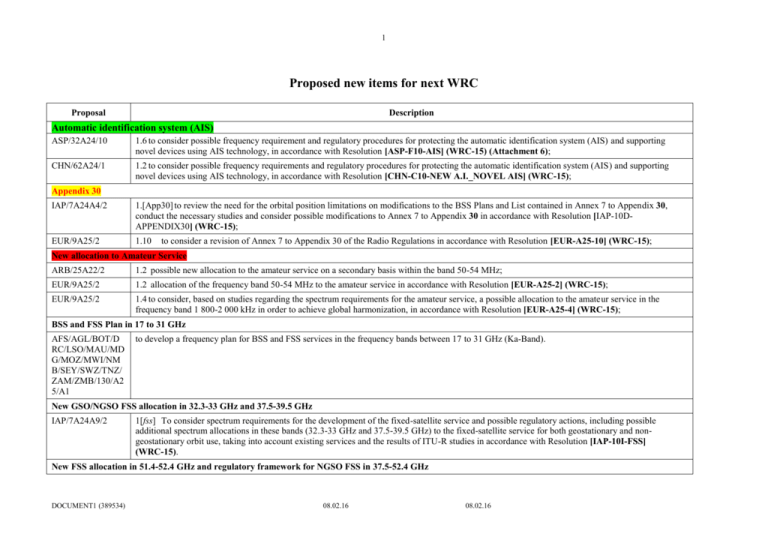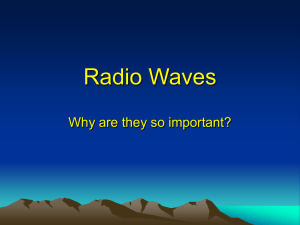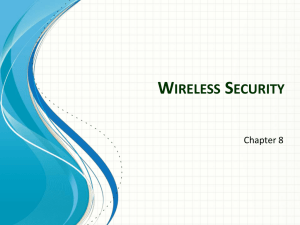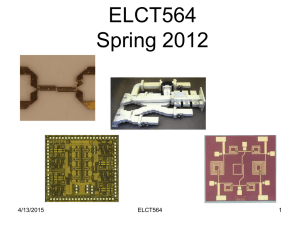List of the Proposed Ageda Items for WRC-19
advertisement

1 Proposed new items for next WRC Proposal Description Automatic identification system (AIS) ASP/32A24/10 1.6 to consider possible frequency requirement and regulatory procedures for protecting the automatic identification system (AIS) and supporting novel devices using AIS technology, in accordance with Resolution [ASP-F10-AIS] (WRC-15) (Attachment 6); CHN/62A24/1 1.2 to consider possible frequency requirements and regulatory procedures for protecting the automatic identification system (AIS) and supporting novel devices using AIS technology, in accordance with Resolution [CHN-C10-NEW A.I._NOVEL AIS] (WRC-15); Appendix 30 IAP/7A24A4/2 1.[App30] to review the need for the orbital position limitations on modifications to the BSS Plans and List contained in Annex 7 to Appendix 30, conduct the necessary studies and consider possible modifications to Annex 7 to Appendix 30 in accordance with Resolution [IAP-10DAPPENDIX30] (WRC-15); EUR/9A25/2 1.10 to consider a revision of Annex 7 to Appendix 30 of the Radio Regulations in accordance with Resolution [EUR-A25-10] (WRC-15); New allocation to Amateur Service ARB/25A22/2 1.2 possible new allocation to the amateur service on a secondary basis within the band 50-54 MHz; EUR/9A25/2 1.2 allocation of the frequency band 50-54 MHz to the amateur service in accordance with Resolution [EUR-A25-2] (WRC-15); EUR/9A25/2 1.4 to consider, based on studies regarding the spectrum requirements for the amateur service, a possible allocation to the amateur service in the frequency band 1 800-2 000 kHz in order to achieve global harmonization, in accordance with Resolution [EUR-A25-4] (WRC-15); BSS and FSS Plan in 17 to 31 GHz AFS/AGL/BOT/D RC/LSO/MAU/MD G/MOZ/MWI/NM B/SEY/SWZ/TNZ/ ZAM/ZMB/130/A2 5/A1 to develop a frequency plan for BSS and FSS services in the frequency bands between 17 to 31 GHz (Ka-Band). New GSO/NGSO FSS allocation in 32.3-33 GHz and 37.5-39.5 GHz IAP/7A24A9/2 1[fss] To consider spectrum requirements for the development of the fixed-satellite service and possible regulatory actions, including possible additional spectrum allocations in these bands (32.3-33 GHz and 37.5-39.5 GHz) to the fixed-satellite service for both geostationary and nongeostationary orbit use, taking into account existing services and the results of ITU-R studies in accordance with Resolution [IAP-10I-FSS] (WRC-15). New FSS allocation in 51.4-52.4 GHz and regulatory framework for NGSO FSS in 37.5-52.4 GHz DOCUMENT1 (389534) 08.02.16 08.02.16 2 Proposal EUR/9A25/2 Description 1.5 to consider an additional primary allocation to the fixed-satellite service (Earth-to-space) in the frequency band 51.4-52.4 GHz and regulatory framework related to Non-GSO FSS systems in the range 37.5-52.4 GHz in accordance with Resolution [EUR-A25-5] (WRC-15); Earth stations on mobile platforms EUR/9A25/2 1.9 to consider the use of the frequency bands 17.7-19.7 GHz and 27.5-29.5 GHz by earth stations on mobile platforms communicating with geostationary space stations in the fixed-satellite service, in accordance with Resolution [EUR-A25-9] (WRC-15); Earth stations on aircraft in FSS / 12.75-13.25 GHz (Earth-to-space) USA/6A24/2 2.XX To develop regulatory means and associated conditions that would provide for the operation of earth stations on aircraft in the FSS in the frequency band 12.75-13.25 GHz (Earth-to-space) in accordance with Resolution [USA-A10-ESOA] (WRC-15). New allocations to EESS / in 40-50 GHz IAP/7A24A7/1 WRC-23 2.[40-50] to review the Table of Frequency Allocations with a view towards modifications to support the allocation of Earth exploration-satellite (active) service in the 40-50 MHz frequency range, in accordance with Resolution [IAP-10G-40-50] (WRC-15); Power limits in the 401-403 MHz and 399.9-400.05 MHz EUR/9A25/2 1.6 to consider establishment of mandatory power limits within maritime mobile satellite, meteorological satellite service or Earth exploration-satellite service in the 401-403 MHz and 399.9-400.05 MHz frequency bands, in accordance with Resolution [EUR-A25-6] (WRC-15); Electronic news gathering AFS/AGL/BOT/D RC/LSO/MAU/MD G/MOZ/MWI/NM B/SEY/SWZ/TNZ/ ZAM/ZMB/130/A2 5/A2 Studies on availability of frequency bands and/or tuning ranges for worldwide and/or regional harmonization and conditions for their use by terrestrial electronic news gathering: systems (Resolution ITU-R 59). GADSS - Global Aeronautical Distress and Safety System ASP/32A24/9 1.5 to consider regulatory provisions to facilitate the introduction of GADSS in aeronautical services bands in accordance with Resolution [ASP-E10GADSS] (WRC-15) (Attachment 5); EUR/9A25/2 1.11 to consider regulatory actions for the development and implementation of the Global Aeronautical Distress and Safety System (GADSS) in accordance with Resolution [EUR-A25-11] (WRC-15); IAP/7A24A3/2 1[GADSS] to consider regulatory actions, including spectrum allocations, to address evolving needs of the Global Aeronautical Distress and Safety System in accordance with Resolution [IAP-10C-GADSS] (WRC-15); ICAO/17/AI10 ICAO Position: To support the inclusion of an item on the agenda of a future World Radiocommunication Conference to address the needs of the global aeronautical distress and safety system DOCUMENT1 (389534) 08.02.16 08.02.16 3 Proposal Description GMDSS - Global Maritime Distress and Safety System ASP/32A24/8 1.4 to consider regulatory actions, including spectrum allocations, to support GMDSS modernization and implementation of e-navigation in accordance with Resolution 359 (Rev.WRC-15) (Attachment 4); IAP/7A24A5/2 1.[GMDSS] to consider regulatory actions, including spectrum allocations, to support GMDSS modernization, implementation of e-navigation and recognition of new service providers in the GMDSS, in accordance with Resolution 359 (Rev.WRC-15); HAPS IAP/7A24A6/2 1[HAPS] to consider, on the basis of ITU-R studies in accordance with Resolution [IAP-10F-HAPS] (WRC-15), appropriate regulatory actions, potentially including expansion of existing identifications for HAPS links within existing fixed service allocations, by revising geographic, technical, and regulatory restrictions associated with existing HAPS identifications, and identifying additional frequency ranges (including any appropriate regulatory and technical conditions) for use by HAPS, within existing fixed service allocations; IMT above 6 GHz AFS/AGL/BOT/D RC/LSO/MAU/MD G/MOZ/MWI/NM B/SEY/SWZ/TNZ/ ZAM/ZMB/130/A2 5/A3 Support for studies on frequency-related matters for IMT identification including possible additional allocations to the mobile services on a primary basis in portion(s) of the following frequency bands for the future development of IMT for 2020 and beyond: i) 26.5-27.5 GHz ii) 31.8-33.4 GHz iii) 40.5-43.5 GHz iv) 45.5-47.0 GHz v) 47.2-47.5 GHz vi) 48.54-49.44 GHz vii) 50.4-52.6 GHz viii) 66-71 GHz ix) 71-76 GHz x) 81-86 GHz. EUR/9A25/2 1.1 to consider additional spectrum allocations to the mobile service on a primary basis and identification of frequency bands for International Mobile Telecommunications, in accordance with Resolution [EUR-A25-1] (WRC-15); KOR/102A24/1 It is proposed that: – all frequency ranges provided by regional groups should be consolidated without further examination and studied by the responsible group for the next study period, taking into account the need for global/regional harmonization of spectrum. Proposed frequency bands by individual administrations could be included based on discussion; – a number of frequency bands could be grouped taking into account the implementable bandwidths based on the advanced technologies. S/78/A2 Proposals DOCUMENT1 (389534) 08.02.16 08.02.16 4 Proposal Description – The frequency ranges proposed by the regional groups should be included in the list of frequency bands to be studied under the new agenda item. – Other frequency ranges, already allocated to the mobile service on a primary basis, supported by an administration, should also be included in the scope of the study. – The frequency ranges for studies should include sufficient amount of spectrum in the ranges 6-10 GHz and 10-30 GHz in addition to bands above 30 GHz. – Sufficient amount of spectrum should be included in order to ensure that WRC-19 will be able to respond to the requirements. B/70A24/1 1[IMT6GHz] to consider the identification of frequency ranges to IMT in the range between 10 GHz and 76 GHz, in accordance with Resolution [BB10] (WRC 15); CHN/62A24/1 1.3 to consider identification of frequency bands for IMT in portion(s) of the frequency range between 22 and 86 GHz including possible additional allocations to the mobile service on a primary basis in accordance with Resolution [CHN-D10-NEW A.I._IMT_ABOVE_6GHZ] (WRC-15); RCC/8A25/2 1.1 to consider possible additional spectrum allocations to the mobile service on a primary basis and identification of additional frequency bands for International Mobile Telecommunications (IMT) in the frequency bands, or parts of the frequency bands, 25.5-27.5 GHz, 31.8-33.4 GHz, 39.540.5 GHz, 40.5-41.5 GHz, 45.5-47.5 GHz, 48.5-50.2 GHz, 50.4-52.6 GHz, 66-71 GHz, 71-76 GHz and 81-86 GHz, in accordance with Resolution [RCC-B10-IMT TBD] (WRC-15); ARB/25A22/2 1.1 to consider additional spectrum allocations to the mobile service on a primary basis and identification of frequency bands above 31 GHz for International Mobile Telecommunications (IMT) and related regulatory provisions, to facilitate the development of terrestrial mobile broadband applications; BEN/BFA/CTI/ GHA/GUI/MLI/NG R/NIG/ SEN/SRL/TGO/ 104/1 to conduct studies on frequencies between 6 GHz to 100 GHz excluding the under listed frequency bands to guide decisions at WRC-19: 1 5 925 to 7 075 MHz 2 10.70 to 14.8 GHz 3 17.3 to 21.2 GHz 4 21.4 to 22.0 GHz 5 27.5 to 31.0 GHz ASP/32A24/5 1.1 to consider identification of frequency bands for IMT including possible additional allocations to the mobile service on a primary basis in accordance with Resolution [ASP-B10-IMT ABOVE 6 GHz] (WRC-15) (Attachment 1); IAP/7A24A11/1 1[IMT6GHz] to consider the identification of frequency ranges to IMT in the range between 10 GHz and 76 GHz, in accordance with Resolution [IAP-10K-IMT6GHz] (WRC-15); IND/107A24/5 1.1 to consider identification of frequency bands for IMT including possible additional allocations to the mobile service on a primary basis in accordance with Resolution [IND-B10- IMT_ABOVE_6GHz] (WRC-15) (Attachment 1); J/SGN/117 Proposals Based on the discussion in Section 2 above, Japan and Singapore propose to adopt the following principles when discussing the new agenda item for WRC-19 regarding IMT identification in the frequency bands above 6 GHz: DOCUMENT1 (389534) 08.02.16 08.02.16 5 Proposal Description – The frequency ranges proposed by the regional groups should be included in the scope of the study under the new agenda item. Furthermore, the frequency ranges supported by some administrations, which are not covered by the regional groups’ proposals, should also be included in the scope of the study. – Excluding some of the frequency ranges, before considering the results of sharing/compatibility studies, in particular, excluding the frequency bands that are already allocated to the mobile service on a primary basis, is not appropriate and should be avoided; – It is essential to include frequency ranges between 6-30 GHz for study under this new agenda item as various use cases and associated requirements for IMT in the bands above 6 GHz will be further elaborated in the next study cycle. In other words, frequency ranges to be studied under this agenda item should be carefully selected considering the balance between lower range (6-30 GHz) and middle & higher ranges (30-100 GHz). Considering the above aspects, in addition to the frequency ranges indicated in the ACP, Japan and Singapore also propose to include the following frequency ranges for study under this agenda item: – 6-8.5 GHz, 10-10.5 GHz, 14.4-15.35 GHz, 25.5-29.5 GHz, and 37-39 GHz. UGA/82A24/1 Future of 5G/IMT above 6 GHz keeping in view current usage, existing services in and adjacent to ranges proposed for study, trends in usage and time to conduct studies among others ISM IND/107A24/6 1.2 to consider identification of frequency bands for ISM applications including possible additional allocations to the ISM on a primary basis around 60 GHz and higher bands; ITS ASP/32A24/7 1.3 to consider spectrum-related matters and possible regulatory actions for Intelligent Transport Systems (ITS) applications, taking into account the results of ITU-R studies, in accordance with Resolution [ASP-D10-ITS] (WRC-15) (Attachment 3); unauthorized operation of earth station / ITU-R Resolution 64 ARB/144/1 1 to conduct studies to examine whether there is a need for possible additional measures in order to limit uplink transmissions of terminals to those authorized terminals in accordance with No. 18.1; 2 to study the possible methods that will assist administrations in managing the unauthorized operation of earth station terminals deployed within its territory, as a tool to guide their national spectrum management programme. New allocation to mobile and fixed services / 275-1000 GHz ASP/32A24/6 1.2 to consider the appropriate regulatory measures to identify the land mobile and fixed services operating in the frequency range 275-1 000 GHz in accordance with Resolution [ASP-C10-MS&FS ABOVE 275GHz] (WRC-15) (Attachment 2); EUR/9A25/2 1.3 to consider identification by footnote for the land mobile and fixed services in the range 275-450 GHz, while maintaining the protection to passive services, subject to No. 5.565, in accordance with Resolution [EUR-A25-3] (WRC-15); Upgrading of the secondary allocation to the Meteorological-SS and EESS in the band 460-470 MHz IAP/7A24A1/1 DOCUMENT1 (389534) X.X to review the allocations to the meteorological-satellite service in the 460-470 MHz band with a view to upgrade the secondary meteorological- 08.02.16 08.02.16 6 Proposal Description satellite service allocation to primary status while protecting the existing primary services in the band, and without imposing any additional constraints on these primary services in accordance with Resolution [IAP-10A-460-470] (WRC-15); EUR/9A25/2 1.7 to consider an upgrade of the secondary allocation to the Meteorological-satellite service (space-to-Earth) in the band 460-470 MHz and to the Earth exploration-satellite service (space-to-Earth), as contained in No. 5.289, to a primary status, while putting relevant constraints on this service in order to protect the existing primary services in the band, in accordance with Resolution [EUR-A25-7] (WRC-15); Maritime radio devices EUR/9A25/2 1.12 to consider regulatory provisions, including spectrum allocations, regarding maritime radio devices operating without regulatory connection to vessels or coast stations to ensure safety of navigation and to protect the integrity of the GMDSS in accordance with Resolution [EUR-A25-12] (WRC-15); Nanosatellite and picosatellite ARB/25A22/2 1.3 to consider modifications to the regulatory procedures for notifying satellite networks to accommodate nanosatellite and picosatellite missions in accordance with Resolution 757 (WRC-12), taking into account the frequency bands used by other space services such that changes to the RR do not lead to the potential for harmful interference to other services, and that the accommodation of nanosatellite and picosatellite systems should not inadvertently affect the regulatory procedures for other satellite systems; New allocations to the space operation service in the range 137-174 MHz and 230-470 MHz EUR/9A25/2 1.8 to consider allocations to the space operation service in the range 137-174 MHz and 230-470 MHz to accommodate the growing number of small non-GSO satellites, in accordance with Resolution [EUR-A25-8] (WRC-15); Res 359 & 757 CPM/6/AI10 6/10/1 WRCpreliminary agenda item 2.1 – Resolution 359 (WRC 12) No CPM text has been developed on this part of the CPM Report. CPM/6/AI10 6/10/2 WRC-18* preliminary agenda item 2.2 – Resolution 757 (WRC 12) See Section 5/9.1.8 in Chapter 5 of this CPM Report to WRC-15. Space weather sensors IAP/7A24A10/1 WRC-23 2.[SW] in accordance with Resolution [ IAP-10J-SW] (WRC-15), to review the results of studies relating to the technical and operational characteristics, spectrum requirements and appropriate radio service designations for space weather sensors with a view to providing appropriate recognition and protection in the Radio Regulations without placing additional constraints on incumbent services; Next-generation radiocommunication systems between train and tracksides ASP/32A24/11 1.7 to consider spectrum-related matters and possible regulatory actions to support the next-generation radiocommunication systems between train and tracksides, in accordance with Resolution [ASP-G10-TRAIN] (WRC-15) (Attachment 7); CHN/62A24/1 1.1 to consider spectrum related matters and possible regulatory actions to support the next generation radiocommunication systems between train and DOCUMENT1 (389534) 08.02.16 08.02.16 7 Proposal Description trackside, in accordance with Resolution [CHN-B10-NEW A.I._RAILWAY] (WRC-15); NGSO FSS satellite systems IAP/7A24A8/2 1.[Vband] to develop a regulatory framework that provides specific regulatory provisions for NGSO FSS satellite systems operating in the 37.542.5 GHz (space-to-Earth) and 42.5-43.5 GHz, 49.2-50.2 GHz and 50.4-51.4 GHz (Earth-to-space) frequency bands in accordance with Resolution [IAP-10H-V-BAND] (WRC-15); WAS including radio local area networks (RLAN) IAP/7A24A2/2 1.[5 GHz] to consider additional spectrum allocations to the mobile service on a primary basis and related regulatory provisions for implementation of wireless access systems (WAS) including radio local area networks (RLAN) in the 5 350-5 470 MHz frequency range to facilitate the development of terrestrial mobile broadband applications in accordance with Resolution [IAP-10B-5GHz] (WRC-15); DNK/F/GRC/ HNG/IRL/ISL/ CZE/G/SVN/S/ TUR/ 81/1 1.[5 GHz] to consider spectrum sharing technologies, additional in band sharing mechanisms and mitigation techniques that could be applied to Wireless Access Systems (WAS) including radio local area networks in the 5 GHz range, and take the appropriate actions in accordance with draft new Resolution [81-B24-5GHz] (WRC-15); WPT ASP/32A24/12 1.8 to consider spectrum-related matters and regulatory actions to support wireless power transmission (WPT)1 taking into account the results of ITU-R studies in accordance with Resolution [ASP-H10-WPT] (WRC-15) (Attachment 8); 1 It refers to non-beam Wireless Power Transmission technologies. ______________ DOCUMENT1 (389534) 08.02.16 08.02.16





